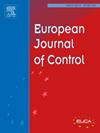Experimental closed-loop flow separation control: Data- and phenomenological-driven approaches
Abstract
Flow control aims at modifying a natural flow state to reach an other flow state considered as advantageous. In this paper, active feedback flow separation control is investigated with two different closed-loop control strategies, involving a reference signal tracking architecture. Firstly, a data-driven control law, leading to a linear (integral) controller is employed. Secondly, a phenomenological/model-driven approach, leading to a non-linear positive (integral) control strategy is investigated. While the former benefits of a tuning simplicity, the latter prevents undesirable effects and formally guarantees closed-loop stability. Both control approaches were validated through wind tunnel experiments of flow separation control over a movable NACA 4412 plain flap. These control laws were designed with respect to hot-film measurements, performed over the flap for different deflection angles. Both control approaches proved efficient in avoiding flow separation. The main contribution of this work stands in providing practitioners, simple but yet efficient control design methods for the flow separation phenomena. Equivalently important, a complete validation campaign data-set is also provided.

 求助内容:
求助内容: 应助结果提醒方式:
应助结果提醒方式:


